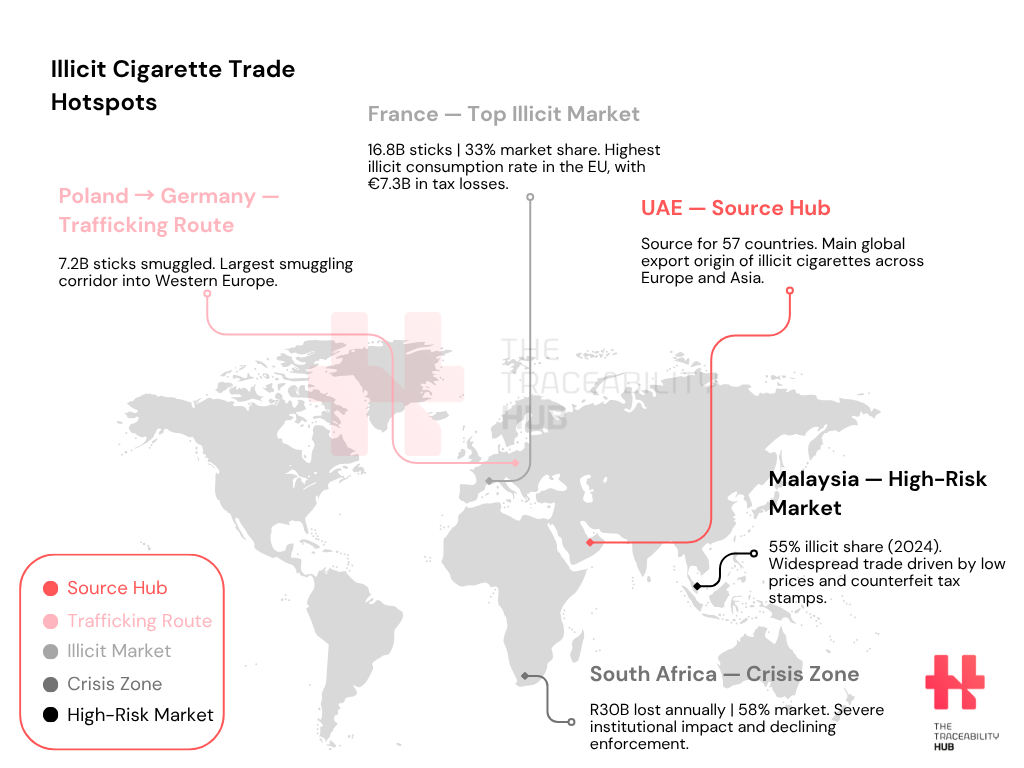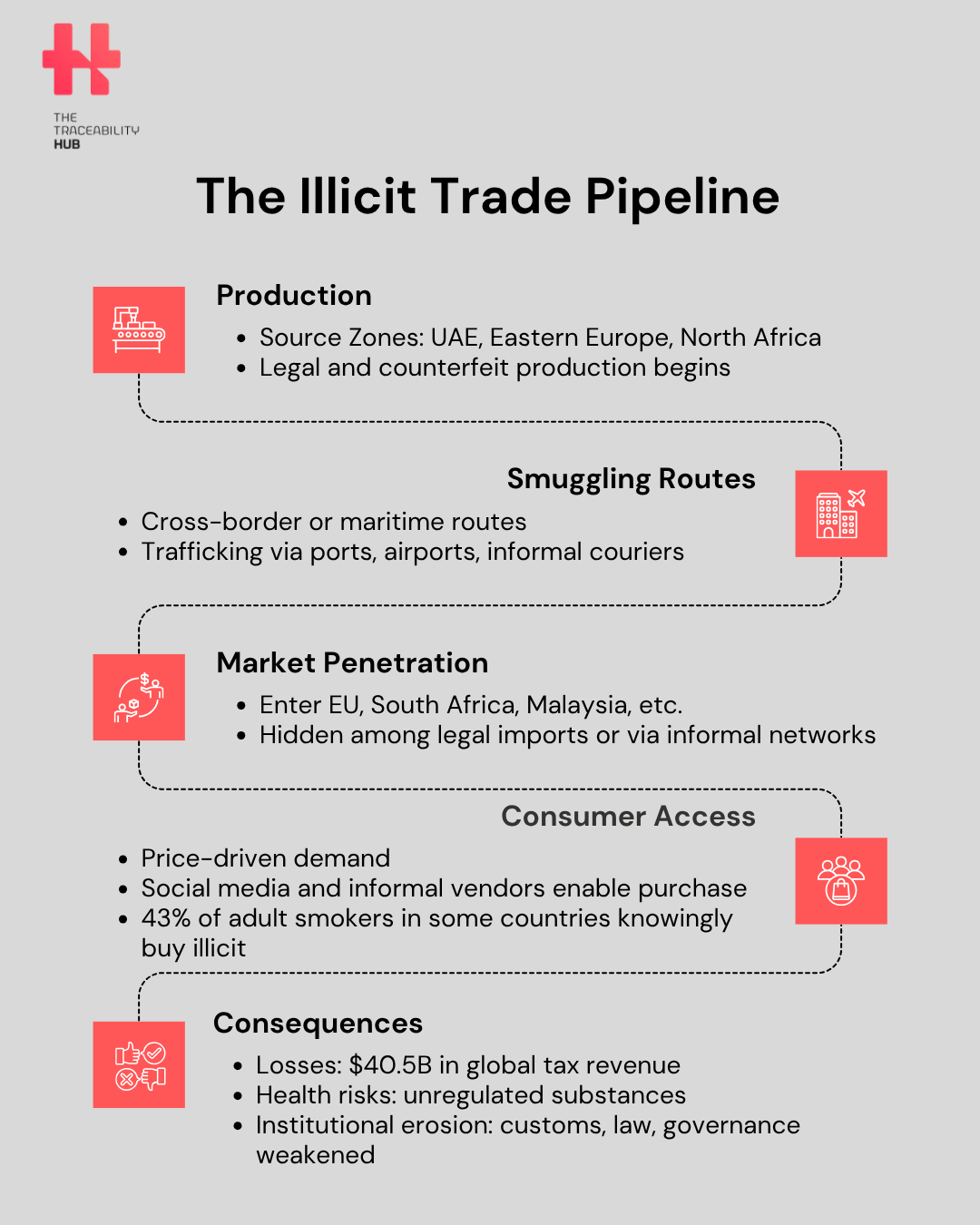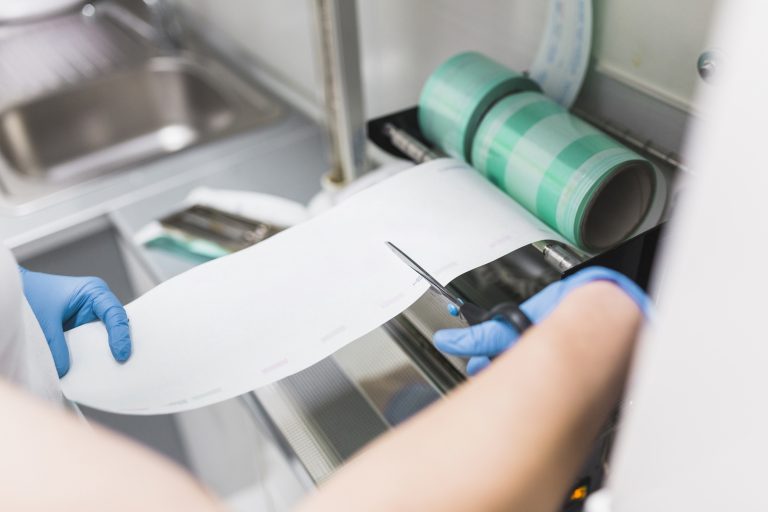The illicit cigarettes market makes up 11.6% of global cigarette consumption. Governments worldwide lose $40.5 billion in tax revenue each year. This hidden economy operates openly, with South Africa’s illegal products controlling 58% of their cigarette market. The numbers paint a concerning picture – Malaysia faces a 55% illicit market share while France stands as Europe’s biggest market for illegal cigarettes with 16.8 billion sticks consumed yearly.
These tobacco products bypass legal channels to avoid taxation and regulatory oversight. The term “illicit cigarettes” covers different types – from counterfeit versions of prominent brands to “illicit whites.” These products are manufactured legally in their country of origin but end up smuggled and sold illegally elsewhere. The market’s reach goes beyond cigarette tax evasion and runs on organized crime networks worldwide.
The underground cigarette market continues to grow despite law enforcement’s best efforts. Authorities found 113 hidden manufacturing sites across 22 European countries. Queensland made history by seizing 19 million illegal cigarettes worth $20.8 million. Governments now turn to innovative digital strategies to curb this widespread issue. The focus has shifted to identifying illicit cigarettes in South Africa’s market and other regions through advanced detection methods, part of illicit cigarette enforcement.
Illicit Cigarette Trade Costs Governments Billions
The underground tobacco market drains billions from government coffers worldwide. The coffers are including tangible and intangible assets available to a government entity, often considered as a surplus “rainy day fund”, outside of the normal funding and budget allocations.
Nations lose an estimated $40.5-50 billion each year in unpaid tax revenue. This represents roughly 600 billion cigarettes. The financial impact not only weakens tobacco control laws policies but also puts money directly into criminal networks.
Global Tax Losses Reach $40.5 Billion Annually
Different regions feel the impact of revenue loss differently. High-income countries see yearly losses of about $17.6 billion. The situation looks even worse for low and middle-income nations, which lose $22.9 billion in taxes. The European Union’s governments lost €11.6 billion in 2023, up from €11.3 billion in the previous year. The United States stands out as a stark example. Since 2007, cigarette smuggling has cost the country over $79.4 billion, with New York state taking the biggest hit at $21.1 billion. This highlights the scale of the illicit tobacco market.
Illicit Cigarette Market Account for 11.6% of Global Consumption
Illicit cigarettes have reached crisis levels around the world. Right now, illegal products make up 11.6% of all cigarettes consumed globally. This equals 657 billion cigarettes every year. Lower-income regions bear the heaviest burden, where illegal cigarettes make up 12.1% of the market compared to 9.8% in high-income countries. Some nations face even more extreme situations. Malaysia reports that 45% of its market consists of illegal products, while Hong Kong follows at 35% and Pakistan at 26.7%. Brunei tops the list with an astounding 89.8% of cigarettes being illegal. These figures show the urgent need for robust anti-smuggling operations.
Illicit Cigarette Trade Hotspots

What Are Illicit Cigarettes and How Are They Defined?
Illegal cigarettes cover any tobacco products that dodge required duties and taxes. The World Health Organization defines illicit trade as “any practice or conduct prohibited by law which relates to production, shipment, receipt, possession, distribution, sale or purchase of tobacco products”. These products typically fall into three main categories:
- Contraband: Genuine contraband cigarettes smuggled across borders without paying applicable duties
- Counterfeit: Unauthorized copies of branded products manufactured to deceive consumers, often referred to as fake cigarettes
- Illicit whites: Cigarettes legally produced in one country but smuggled and sold in another without paying duties
Stopping the illicit cigarette trade would do more than just recover tax money. It would save an estimated 160,000 lives annually from 2030 onward.
Organized Crime Networks Expand Illicit Cigarette Operations
Criminal gangs have expanded their illegal cigarette operations faster than ever. They now run sophisticated manufacturing and distribution networks across continents. The illegal tobacco trade brings huge profits—up to 900% in some cases. This makes it an attractive option for international organized crime and cigarettes looking for high-reward, low-risk opportunities.
The Illicit Trade Pipeline

How Governments Fight Illicit Tobacco
Europe Sees Rise in Local Clandestine Factories
Police data shows authorities shut down 113 hidden cigarette manufacturing sites in 22 European countries in 2023. Spanish officials found a manufacturing facility buried four meters underground. Workers were locked underground in dangerous conditions without any emergency exits. These illegal tobacco operations bring in massive criminal profits—about €625,000 every week from just one facility. France faces the biggest challenges, with the largest illegal tobacco market in the EU. The country accounts for 47.7% of illegal cigarette consumption in the region. A record 43% of all cigarettes smoked in France are untaxed—the highest number since monitoring started in 2006. This is part of the broader illicit cigarette trade in Europe.
How Smuggling Routes Adapt to Enforcement Pressure
Criminal tobacco networks can adapt quickly to increased police pressure. Russian and Italian mafias often use Cyprus and Montenegro as bases. Drug cartels and American organized crime prefer Aruba and Panama instead. In Southeast Asia, distributors who smuggle from Hong Kong to China also control networks from the Philippines and Singapore. The COVID-19 pandemic pushed criminals to sell online, and they’ve kept doing it even after restrictions ended. The Russia-Ukraine war has changed traditional smuggling routes, forcing criminal groups to adjust and try new approaches. This highlights cross-border cigarette smuggling.
Illicit whites are cigarettes made legally in one country just to be smuggled somewhere else. Unlike fake cigarettes, manufacturers can make these products openly in modern facilities. This helps them avoid getting sued for copying brands while still selling to illegal markets. Yes, it is a growing problem—their share of global illegal tobacco trade jumped from 38% in 2015 to 48% in 2020. The United Arab Emirates leads production, sending 9 billion illegal cigarettes to European and Asian markets. Jin Ling, made in Russia’s Kaliningrad Free Zone, shows this trend perfectly. It has become one of the most confiscated cigarette brands in the European Union.
Country-Specific Crackdowns Reveal Scale of the Problem
Law enforcement operations worldwide have revealed the staggering scale of illicit cigarette market. The latest government crackdowns show how deeply illegal tobacco has penetrated national economies.
India: 91 Million Sticks Seized in 2023/24
The Directorate of Revenue Intelligence report “Smuggling in India 2023-24” shows authorities caught approximately 91 million illegal cigarette sticks worth Indian rupee ₹179.82 crores. Total confiscations reached 17.85 crore sticks valued at Indian rupee ₹308 crore in FY24 when combined with Customs seizures. India now ranks third behind China and Brazil in illicit cigarette volumes, with consumers using 30.2 billion illegal sticks in 2022. The government’s losses from illegal tobacco trade reached Indian rupee ₹13,331 crore in tax revenue during 2022, according to the FICCI Cascade report.
Malaysia: 55% of Market Still Illicit Despite Efforts
Malaysia’s fake cigarettes trade dropped to 55% in 2024 from 55.6% in 2023, yet remains one of the world’s highest rates. The market hit its lowest point since illegal circulation peaked at 63.8% in 2020. Academic studies have challenged these numbers, with new calculations suggesting illegal cigarettes made up about 70% of the market in 2019. Legal cigarette sales continue to decline and now represent just 23.8% of consumption, despite improved enforcement.
South Africa: 58% of Cigarette Market is Illegal
South Africa battles a massive illegal cigarette crisis, with unlawful products controlling 58% of the market in 2022, slightly better than 60% in 2021. The market share jumped dramatically from 5% in 2009. The government lost Rand 15 billion in excise taxes and Rand 3 billion in VAT during 2022 alone, according to a University of Cape Town study. Legal cigarette sales reached only 14.3 billion sticks in 2022, while illegal sales hit 19.4 billion sticks. Any pack priced below Rand 32 likely breaks the law, since excise tax alone costs R21.77. Identifying illicit cigarettes in South Africa’s market is crucial.
France: 33% of Cigarettes Consumed Are Illicit
France leads Europe’s illegal tobacco black market, making up 47.7% of the continent’s total illicit consumption. French consumers used 16.8 billion illegal cigarettes, costing the government €7.3 billion in lost tax revenue. Counterfeit products have exploded in popularity, with estimates showing 8 billion counterfeit cigarettes consumed. Illegal cigarettes now make up 33% of total French consumption, up from 29% in 2021.
Tobacco Companies and Governments Push for Digital Enforcement
Digital enforcement technologies have become vital weapons to fight illicit cigarettes. Paper-based systems don’t deal very well with counterfeiting anymore. Industry leaders and governments now invest in sophisticated digital solutions to protect revenue and curb criminal networks. This marks a transformation in tackling the illegal tobacco trade.
Transition from Paper to Digital Tax Stamps
The change from conventional paper stamps to digital alternatives marks a big breakthrough in enforcement. Traditional tax stamps have minimal security features—usually just a heat-applied decal or watermark with serial numbers—which makes them easy to counterfeit. Digital tax stamps employ encryption technology, scannable codes, color-shifting dyes, and tamper-evident surfaces. This change has produced impressive results. California collected an additional $110 million in revenue after using high-tech stamps without raising excise taxes. The state experienced a 37% decline in cigarette tax evasion within two years. This is a key example of how to combat illicit tobacco.
Public-Private Partnerships to Curb Illicit Trade
The fight against illicit cigarette trade needs both public and private sectors to work together. Philip Morris International’s (PMI) priority focuses on supply chain security through authentication technologies that track products during distribution. Technology forms the foundation for these partnerships—from machine learning that spots illegal online sales to digital track and trace cigarettes systems that verify product authenticity. Mutually beneficial collaboration between governments, private companies, and civil society has proven vital to tackle this global challenge, aligning with the WHO Protocol to Eliminate Illicit Trade and EU tobacco directive traceability.
How to Identify Illicit Cigarettes in South Africa
South African consumers can spot illicit cigarettes through five key packaging indicators:
- Missing excise marking (diamond stamp)
- Absent or incorrect health warnings
- Tar/nicotine readings that exceed legal limits (12mg tar/1.2mg nicotine) or appear in wrong positions
- Incorrect or missing quit line number
- Absence of “reduced ignition propensity” text
Price offers a simple way to verify—any pack selling below Rand 20 is likely illicit, as this amount represents the minimum tax (R16.66 excise plus VAT). South African authorities now implement track-and-trace marker technology based on Kenya’s successful model, which reduced illicit cigarette trade by a lot. This directly addresses how to identify illicit cigarettes.
The Growing Fight Against Illicit Cigarettes
The worldwide battle against illegal cigarettes keeps getting bigger as governments lose massive amounts of revenue. Without doubt, this illegal cigarette underground economy has grown to 11.6% of worldwide cigarette consumption and just needs immediate action. The problem runs deep in many national economies. South Africa faces 58% market penetration while Malaysia deals with 55%.
Criminal networks have spotted a goldmine here, with profit margins reaching 900% in some cases. These criminals run complex operations across continents. They keep adapting to law enforcement by finding new smuggling routes and better manufacturing methods. Law enforcement agencies find themselves playing an endless game of cat-and-mouse with these clever networks.
Governments and tobacco companies have started to move toward digital solutions. Digital tax stamps now come with encryption, scannable codes, and tamper-proof features that work better than old paper systems. On top of that, the public and private sectors work together to track products through distribution chains, which makes illegal trade harder.
Some bright spots have emerged despite these challenges. California’s new high-tech stamps brought in $110 million more revenue without any tax increases. The California Department of Tax and Fee Administration (CDTFA) introduced an enhanced green to blue color. Malaysia’s illegal market has also shown a small drop from previous years. A complete strategy that combines digital enforcement, international teamwork, and public awareness offers the best way forward.
The fight against illegal cigarettes needs constant attention. This trade doesn’t just cost billions in lost taxes – it hurts public health programs and puts money in criminals’ pockets. This shadow economy will keep growing at everyone’s expense until governments worldwide join forces with better technology and coordinated action. This highlights why illegal cigarettes are dangerous and the impact of illegal tobacco.
Read more: From Transparency to Tariffs: How Supply Chain Visibility Is Reshaping Global Trade Dynamics






